Finding dark sky sites for your astronomy club requires understanding the Bortle Scale (1-9) and utilizing light pollution maps. Look for locations rated Bortle 1-3, consider elevation for clearer viewing, and explore certified dark sky locations like national parks. Coordinate trips with new moon phases and seasonal celestial events. Don’t forget accessibility, safety, and necessary permissions when selecting sites. Partner with local organizations and parks for regular observing locations. The perfect stargazing spot awaits beyond the city lights.
NUMERIC LIST OF 12 SECOND-LEVEL HEADING(S) IN ENGLISH
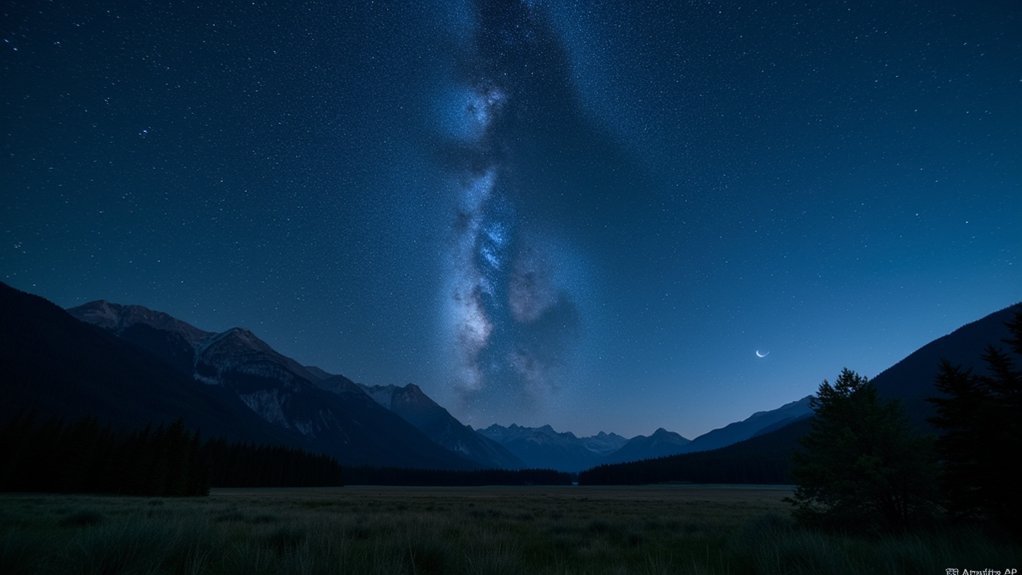
Several key topics comprise our exploration of dark sky astronomy destinations. When examining potential dark sites for your club, these 12 essential areas require attention:
- Light Pollution Measurement
- Site Accessibility
- Permission Requirements
- Safety Considerations
- Weather Patterns
- Horizon Visibility
- Elevation Benefits
- Seasonal Availability
- Equipment Transportation
- Camping Facilities
- International Dark Sky Parks
- Public Outreach Opportunities
You’ll need to evaluate each category thoroughly when selecting ideal viewing locations.
Consider how light pollution affects visibility, whether you’ll need special permission to access sites, and if the area provides adequate safety for nighttime observation.
Don’t overlook practical concerns like getting heavy equipment to remote dark sites or whether facilities exist for overnight stays.
Proper assessment of these factors will greatly improve your astronomy club’s observing experiences.
Understanding the Bortle Scale for Astro Club Site Selection
Every successful astronomy club relies on the Bortle Scale when selecting ideal observation sites. This 1-9 classification system helps you identify locations with minimal light pollution, which directly impacts your stargazing experience.
While most members likely live in Bortle Class 5 areas with moderate light pollution, you’ll want to seek out darker skies for club events. Bortle Class 2 sites offer excellent viewing conditions where the Milky Way and numerous deep-sky objects become readily visible.
| Bortle Class | Light Pollution | Observation Quality |
|---|---|---|
| 1 | Minimal | Exceptional |
| 2 | Very Low | Excellent |
| 5 | Moderate | Limited |
| 8-9 | Severe | Poor |
| 1-2 | Ideal Target | Club Priority |
For ideal astronomical observations, prioritize locations rated Bortle Class 1 or 2 whenever possible.
Utilizing Light Pollution Maps for Group Observations
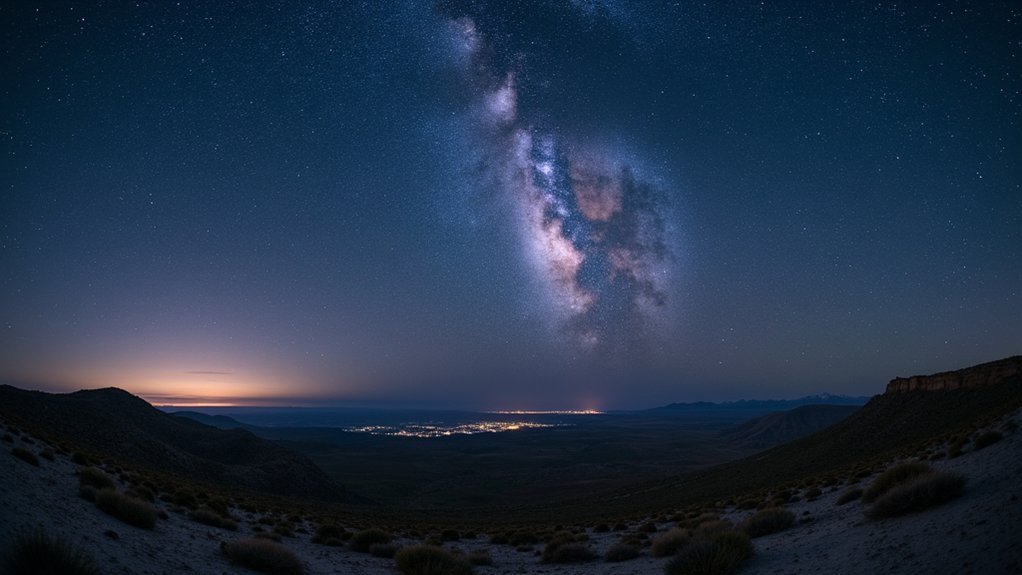
Light pollution maps offer your astronomy club essential guidance for finding Bortle-optimal observation sites with color-coded zones indicating sky darkness levels.
You’ll want to focus on yellow to gray areas when planning group stargazing events, ensuring members can access locations that balance darkness quality with reasonable travel distances.
When selecting sites for your next club outing, prioritize locations that have maintained or improved their darkness ratings in recent years, particularly those with protective designations like International Dark Sky Parks.
Bortle Scale Navigation
While most amateur astronomers understand the basic concept of light pollution, charting the Bortle Scale can transform your astronomy club’s observation planning.
Steering from your Bortle 5 suburban location to dark skies rated Bortle 1-3 doesn’t require guesswork when you use light pollution maps effectively.
- Identify your home base – Use lightpollutionmap.info to determine your local Bortle class and understand what celestial objects are realistically visible from your regular meeting spots.
- Target the colors – Plan club expeditions to yellow (Bortle 4), green (3), blue (2), or gray (1) zones on the map for progressively better viewing conditions.
- Leverage protected areas – National and state parks often offer the darkest skies, making them perfect destinations for scheduled group observations of faint deep-sky objects.
Site Selection Strategies
When astronomy clubs gather for observation sessions, choosing the right location can mean the difference between a frustrating night of faint smudges and a breathtaking cosmic showcase.
Start by consulting light pollution maps like lightpollutionmap.info to identify yellow, green, blue, or gray zones where dark sky conditions prevail.
Prioritize sites with Bortle ratings of 1-3, as these offer ideal visibility for deep-sky objects.
Consider elevation too—higher altitudes generally provide clearer atmospheric conditions and reduced humidity.
Time your club outings to coincide with meteor showers or eclipses to maximize the experience.
Don’t overlook the value of member feedback; encourage your group to share insights from previous dark sky visits.
This collaborative approach guarantees each subsequent outing benefits from collective experience.
Member-Accessible Dark Locations
Organizing successful club observation sessions demands locating accessible dark skies that all members can reach. Use lightpollutionmap.info to identify Bortle class 1-4 areas within reasonable driving distance of your membership base. The opacity slider helps visualize light pollution gradients, making it easier to find the sweet spot between darkness and accessibility.
- Prioritize International Dark Sky Parks and Reserves that offer astronomy-friendly amenities and protected viewing conditions.
- Consider national parks like Big Bend or Arches that combine dark skies with sufficient space for group setups.
- Plan trips around celestial events such as meteor showers, when members are most motivated to travel farther for ideal viewing conditions.
Always scout potential locations during daylight to identify parking, safety concerns, and gathering spaces before bringing the full club.
Certified Dark Sky Locations Suitable for Club Visits
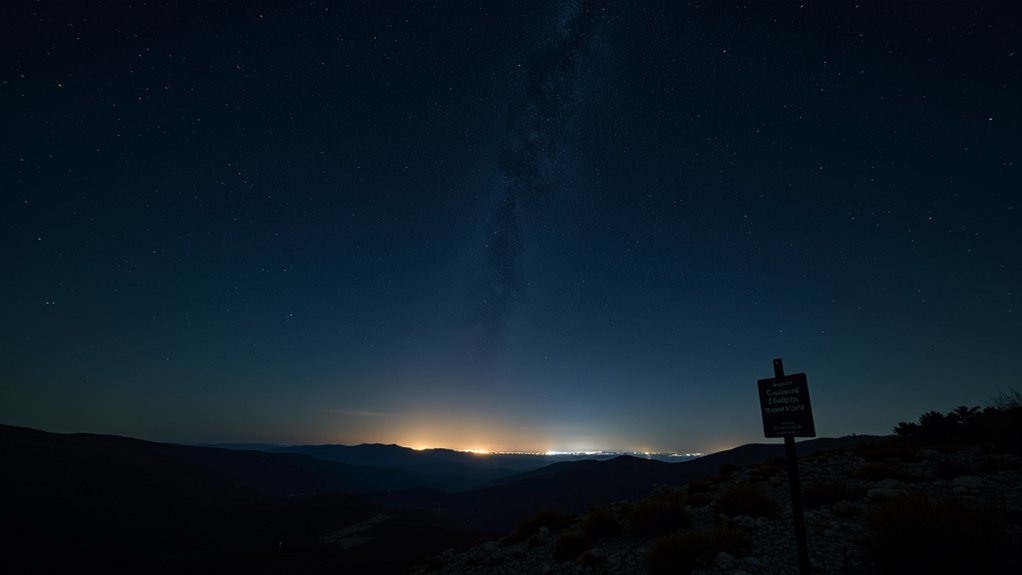
Astronomy clubs can maximize their observational experiences by visiting officially certified dark sky locations like Aoraki Mackenzie Reserve in New Zealand or Big Bend National Park in Texas.
You’ll benefit from these sites’ minimal light pollution, which allows your group to witness celestial phenomena that remain invisible in urban settings.
When planning your club’s excursion to locations such as Antelope Island State Park, consider seasonal celestial events, member transportation logistics, and equipment needs to guarantee a rewarding stargazing adventure.
Perfect Sites Nationwide
Five exceptional certified dark sky locations across the United States offer astronomy clubs ideal settings for memorable stargazing expeditions.
From Flagstaff, Arizona—the first International Dark Sky City—to Big Bend National Park’s hiking trails complemented by pristine dark skies, your club has outstanding options nationwide.
The Appalachian Mountain Club’s Maine Woods Initiative provides eastern astronomers with 400+ square kilometers of protected land with minimal light pollution.
- Anza-Borrego Desert State Park – California’s second-largest state park offers vast open spaces perfect for large star parties.
- Big Bend National Park – Combine daytime hiking with nighttime stargazing events.
- Aoraki Mackenzie Reserve – For international trips, New Zealand’s reserve showcases the southern hemisphere’s spectacular Milky Way views.
Don’t limit your club to local observations when these certified sites await your telescopes.
Group Observation Benefits
When astronomy clubs coordinate visits to certified dark sky locations, they gain far more than just clearer views of the cosmos.
These designated sites provide structured environments where members can share equipment, knowledge, and observational techniques in ideal conditions.
At places like Aoraki Mackenzie in New Zealand or Big Bend National Park in the U.S.A., your club will benefit from expansive viewing areas that accommodate multiple telescopes simultaneously.
The International Dark Sky Park designation guarantees that sites like Arches National Park maintain lighting policies specifically designed for astronomical observation.
Visiting Bannau Brycheiniog National Park and similar dark skies locations fosters educational opportunities and community engagement.
Your club can participate in guided programs about light pollution while enjoying unparalleled cosmic views.
Using dark sky maps helps coordinate group visits around celestial events, enhancing the shared experience.
Planning Successful Excursions
Selecting the right certified dark sky location can transform your astronomy club’s observational experience from ordinary to extraordinary.
When planning your next stargazing adventure, consider destinations specifically protected for their pristine dark skies.
The Aoraki Mackenzie International Dark Sky Reserve in New Zealand offers some of the darkest skies in the Southern Hemisphere, while Big Bend National Park in Texas provides remote wilderness perfect for club excursions.
For West Coast groups, Anza-Borrego Desert State Park in California delivers vast, unpolluted night viewing.
For successful club excursions:
- Research seasonal celestial events visible from your chosen location
- Plan multi-day trips to maximize viewing opportunities if weather conditions change
- Contact park rangers in advance for astronomy-specific recommendations and permits
Remember that wilderness areas like Boundary Waters and Maine Woods Initiative offer exceptional dark skies with minimal light pollution.
Establishing Relationships With Local Parks and Preserves
Forging strong connections with local parks and preserves creates invaluable opportunities for amateur astronomers seeking dark skies.
Start by attending community meetings where you can discuss dark sky conservation and potential collaborations with park management.
Approach existing Dark Sky Places in your region and propose partnerships that benefit both parties. You’ll find many park authorities receptive when you highlight the ecological and cultural significance of preserving natural darkness.
Develop a concrete proposal for astronomy events that demonstrates how your club adds value. Offer to conduct educational stargazing programs that can enhance the park’s visitor experience while raising awareness about light pollution issues.
These partnerships not only provide you with better observation conditions but also strengthen community support for both astronomy and conservation efforts.
Planning Seasonal Observing Trips for Maximum Visibility
Successful astronomy excursions depend heavily on thoughtful timing and location selection throughout the year.
To maximize your dark sky experiences, coordinate your trips with the new moon phase when skies are darkest and celestial objects are most visible.
- Track seasonal celestial events – Plan trips around major meteor showers, eclipses, and planetary alignments that occur at specific times of the year.
- Monitor weather patterns – Use forecasting tools to identify clear nights, especially during seasons when your region typically experiences favorable viewing conditions.
- Rotate between dark sky locations – Visit different reserves and national parks throughout the seasons, as some locations offer better visibility during certain months due to local climate variations.
Remember to utilize Dark Sky Maps to identify prime viewing areas with minimal light pollution.
Evaluating Site Accessibility for All Club Members
How can astronomy clubs guarantee that everyone gets to experience the wonder of truly dark skies? When selecting observation locations, you’ll need to take into account physical accessibility alongside astronomical quality.
| Accessibility Factor | What to Evaluate |
|---|---|
| Distance | Verify dark sky sites are within reasonable travel range for all members |
| Amenities | Check for restrooms, adequate parking, and wheelchair access |
| Terrain | Assess if hiking or off-road travel might exclude those with mobility challenges |
| Weather Patterns | Research seasonal conditions that could impact visibility and comfort |
Use light pollution maps to confirm your chosen location offers truly dark skies. Remember that even spectacular sites like Aoraki Mackenzie or Big Bend won’t serve your club well if significant portions of your membership can’t access them comfortably.
Creating a Club Database of Proven Observation Spots
As your astronomy club gathers experience at various dark sky locations, building an extensive database becomes essential for maximizing future observation success.
Start by documenting IDA-certified sites like Big Bend National Park and Aoraki Mackenzie International Dark Sky Reserve, along with locations scoring Bortle class 1-3 on light pollution maps.
- Include detailed information about each dark sky site, noting lighting policies at parks like Anza-Borrego Desert State Park that actively protect night skies.
- Collect member feedback about each location’s actual viewing conditions, accessibility, and performance during different celestial events.
- Maintain regular updates as new dark sky sites are established and as light pollution conditions change in existing locations.
Weather Considerations for Successful Club Stargazing
While finding the perfect dark sky location marks an important first step, monitoring weather conditions ultimately determines whether your astronomy club’s outing succeeds or fails.
Clear, dry skies dramatically enhance visibility of celestial objects, so schedule outings during your region’s least humid seasons.
Plan your stargazing when humidity is lowest—crystal-clear skies reveal the universe’s hidden treasures.
Track atmospheric stability by checking wind forecasts—calm nights offer the sharpest views at your dark sky site.
Remember that seasonal patterns matter; winter often provides superior viewing conditions despite the cold, while summer humidity can diminish even the darkest locations’ effectiveness.
Before departing, consult specialized astronomical forecasts that predict cloud cover, transparency, and seeing conditions.
These tools go beyond standard weather apps, helping you decide when it’s worth making the journey to your carefully selected observation spot.
Equipment Transportation Logistics for Remote Locations
Reaching prime dark sky locations demands careful planning for your valuable astronomical equipment. When organizing equipment transportation logistics, prioritize protective cases that shield sensitive gear from rough terrain and unexpected bumps.
You’ll need a vehicle suitable for the destination—consider off-road capabilities if you’re heading to remote parks like Big Bend or Anza-Borrego where paved roads end.
For successful remote stargazing sessions:
- Pack collapsible and lightweight equipment whenever possible to ease transportation across difficult terrain.
- Map your route using offline GPS tools, as cell service is typically unreliable at prime dark sky sites.
- Include emergency supplies alongside your astronomy gear—extra batteries, first aid kits, and vehicle emergency equipment are essential.
Collaborating With Other Astronomy Clubs on Site Sharing
Building a community around the stars extends beyond individual preparation and equipment. When you collaborate with neighboring astronomy clubs, you’ll gain access to a network of premium dark sky locations while building valuable relationships.
| Collaboration Benefits | Implementation Strategies |
|---|---|
| Expanded site access | Create shared site directories |
| Combined knowledge | Develop Bortle Scale ratings together |
| Resource pooling | Coordinate joint transportation |
| Increased attendance | Schedule alternating host responsibilities |
| Advocacy strength | Partner on dark sky preservation efforts |
Organizing Public Outreach Events at Dark Sky Locations
When organizing public outreach events at dark sky locations, you’ll need to carefully select venues based on both astronomical visibility and accessibility for attendees of varying abilities.
You should develop efficient strategies for transporting delicate telescopes, presentation materials, and safety equipment to remote viewing sites without damage.
Managing volunteers effectively requires clear assignment of roles—from parking coordinators to telescope operators—with scheduled breaks ensuring everyone can enjoy the stargazing experience they’re helping to create.
Venue Selection Considerations
Successful public outreach events at dark sky locations hinge on five critical venue selection factors that can make or break your astronomical gathering. When choosing your site, prioritize International Dark Sky Parks or Reserves, which implement protective lighting policies that dramatically enhance stargazing experiences.
Consider the venue’s altitude and geographic features—higher elevations often provide clearer atmospheric conditions for ideal celestial viewing.
For practical considerations, you’ll want to guarantee:
- Access to basic amenities like restrooms and parking, which are often limited in remote dark sky locations
- Proximity to educational facilities or visitor centers that can supplement your programming
- Timing alignment with notable astronomical events like meteor showers to maximize attendance and engagement
Equipment Transportation Tips
Transporting delicate astronomical equipment to remote dark sky locations requires meticulous planning and protective measures to confirm everything arrives intact and functional. Create an all-encompassing checklist of all necessary gear to make sure nothing’s forgotten when heading out to enjoy pristine night skies.
| Equipment Type | Protection Needed | Transportation Tip |
|---|---|---|
| Telescopes | Padded cases | Disassemble large scopes |
| Binoculars | Hard cases | Use neck straps for hiking |
| Cameras | Waterproof bags | Pack extra batteries |
| Mounts | Original packaging | Remove counterweights |
Consider equipment size and weight when choosing transportation methods. Coordinate with club members to share the load for public outreach events. Don’t forget portable power solutions for remote sites where electricity isn’t available.
Volunteer Management Strategies
Coordinating a dedicated team of volunteers stands as the backbone of successful public outreach events at dark sky locations.
When engaging volunteers to combat light pollution awareness, you’ll foster community ownership while maximizing the impact of your astronomy outreach efforts.
- Assign specific roles to volunteers based on their expertise—designate stargazing guides from your local astronomy club to operate telescopes, light pollution educators to explain dark sky ordinances, and logistics coordinators to manage equipment.
- Create a volunteer training program that includes information on light pollution impacts and how to effectively communicate the importance of Dark Sky Places to visitors.
- Establish a recognition system for dedicated volunteers who consistently participate in outreach events, creating a sense of belonging and appreciation within your astronomy community.
Frequently Asked Questions
How Do I Find Astrophotography Locations?
To find astrophotography locations, use light pollution maps, seek Dark Sky Places, research higher altitude areas, plan around astronomical events, and consider remote rural regions. You’ll capture clearer celestial images with less light interference.
Where Are the Dark Sky Sanctuaries in the US?
In the US, you’ll find Dark Sky Sanctuaries in New Mexico (Cosmic Campground), Pennsylvania (Cherry Springs State Park), and Nevada (Great Basin National Park). These locations offer exceptionally dark skies for ideal stargazing experiences.
Are Dark Sky Parks Worth It?
Yes, Dark Sky Parks are absolutely worth it. You’ll experience stars, galaxies, and celestial events with unprecedented clarity. They’re transformative if you’re passionate about astronomy or simply want to witness truly dark skies.
What Are Dark Sky Discovery Sites?
Dark Sky Discovery Sites are designated areas with minimal light pollution where you’ll experience exceptional stargazing conditions. They’re certified by organizations like IDA and often provide amenities for astronomers seeking clear views of the night sky.
In Summary
Your astronomy club’s hunt for dark skies doesn’t end here. You’ll find that perfect observing site by combining Bortle scale knowledge, light pollution maps, and partnerships with parks and other clubs. Remember, weather patterns and logistics are just as important as darkness levels. As you share these special places with the public, you’re not just seeing better stars – you’re creating advocates for protecting our night skies.

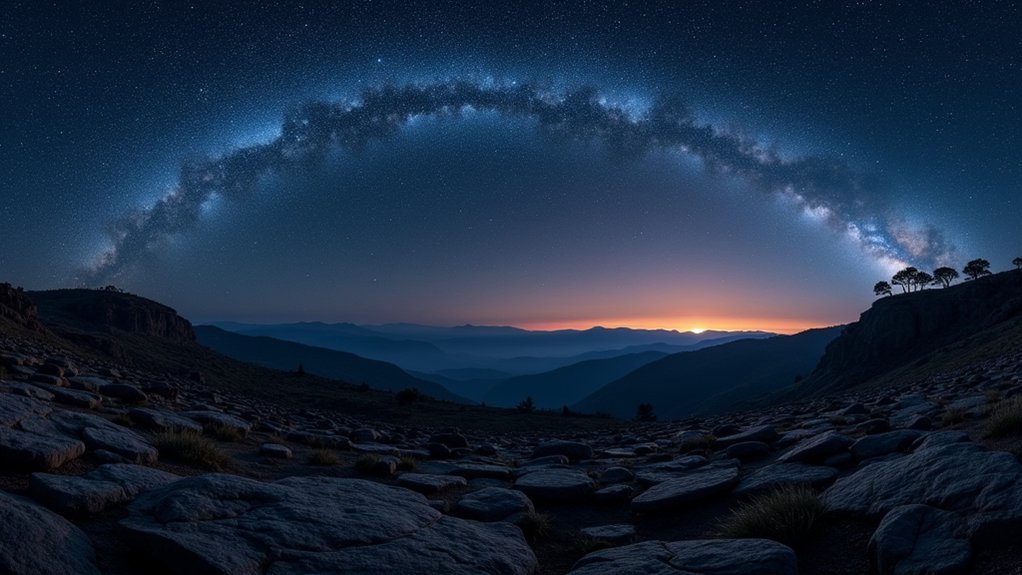
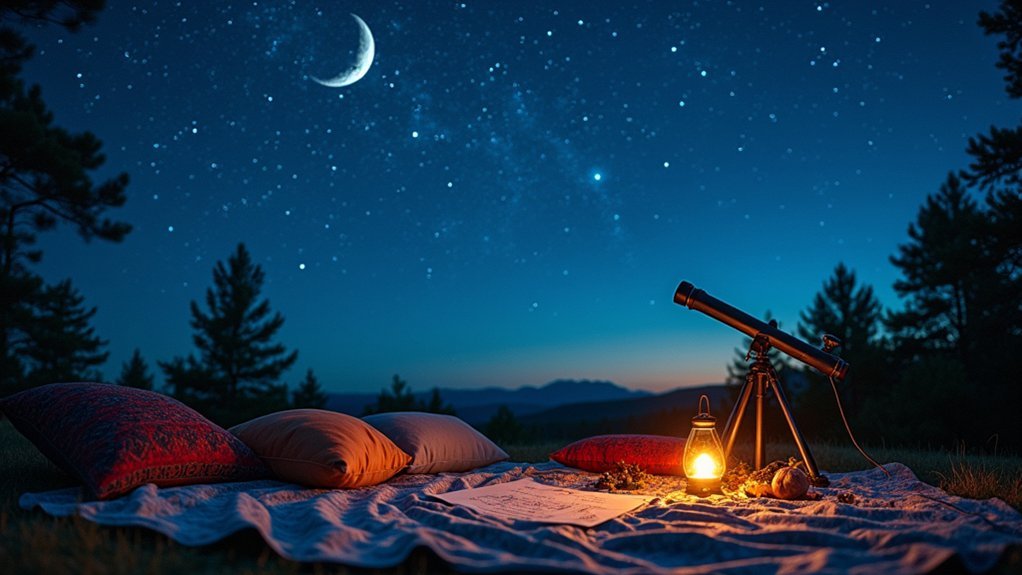
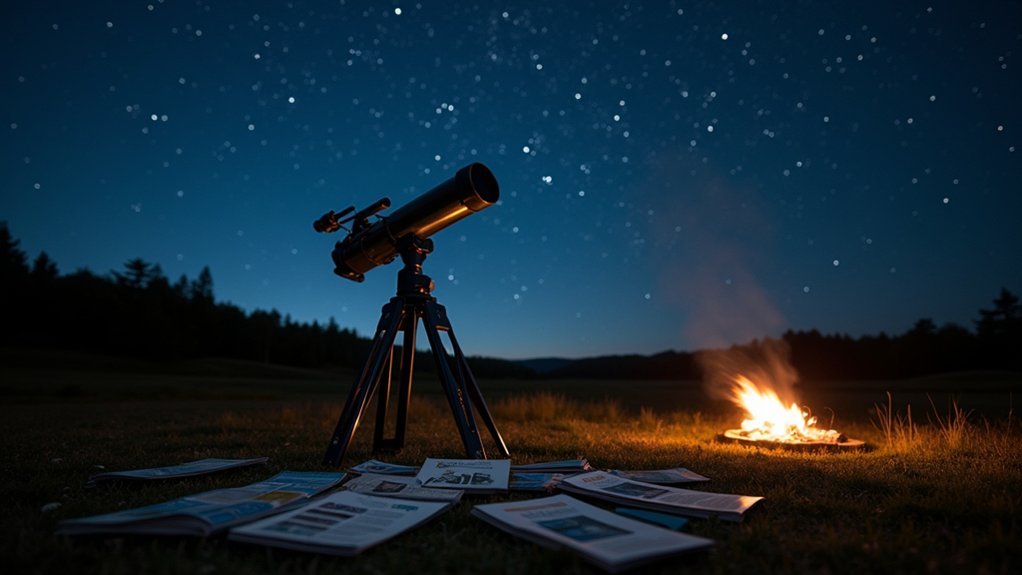
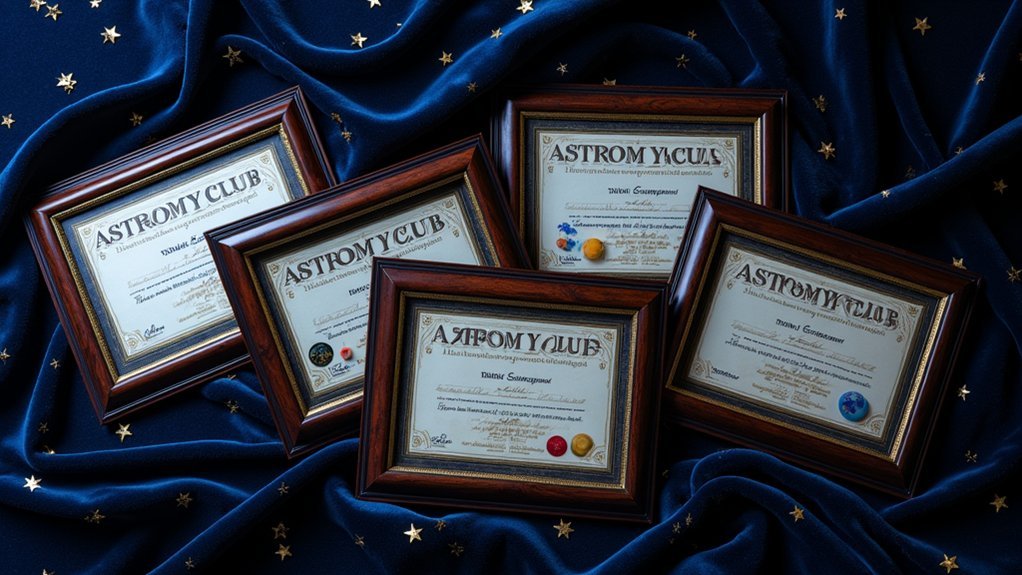
Leave a Reply